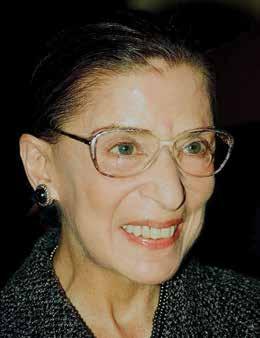
3 minute read
Ruth Bader Ginsburg
Obituary
Ruth Bader Ginsburg

Monica Feria-Tinta pays tribute to #RBG and reflects on meeting her in 2007.
On 18 September, the Supreme Court of United States lost, in its words, ‘a justice of historic stature’. Justice Ruth Bader Ginsburg was the Court’s most prominent member, before passing away at the age of 87. She served for 27 years at the highest court of the United States, becoming one of the most influential legal figures of our times and a cultural icon.
‘A Brooklynite, born and bred’ and a first-generation American on her father’s side, she was taught to love learning and to care about people since early childhood by her parents. Neither of her parents had the means to attend college themselves.
She was one of only nine women in a class of over 500 men at Harvard Law School and became top of the class, making it to the Harvard Law Review the following year. Yet, in her own words, when she graduated from law school in 1959, ‘not a law firm in the entire city of New York would employ [her].’ ‘I became a lawyer in days when women were not wanted by most members of the legal profession’ – she said. The barriers women faced in her lifetime made her realise as she put it, that ‘being a woman was an impediment.’
Her response to the challenges of her time set her out on a journey of her own. For more than a decade, until her first judicial appointment in 1980, she led the fight in the courts for gender equality. She became a formidable advocate for equal rights of women and men and the architect of a legal landscape that fundamentally changed ‘the way the world was for American women’.
She started to build transformative case-law before the US Supreme Court as a litigator in Frontiero v Richardson 411 U.S. 677 (1973). From that moment on, throughout the 1970s, she continued challenging discriminatory laws taking cases that would make good law before the Supreme Court, effectively using the law as a vehicle of change: step by step, in an incremental fashion.
I had the privilege of meeting her in 2007. She chaired the ceremony in which I was awarded the Gruber Justice Prize for leading a ground-breaking case that initiated the feminization of human rights law in Latin America. Petite and fragile in appearance, Justice Ginsburg’s apparent vulnerability contrasted with the fearlessness of her views in her judgments and separate opinions and her laser-sharp precision. We discussed her work at the US Supreme Court, including those cases which raised issues of international law. Sitting down in her office, at the Supreme Court in Washington D.C., it seemed perfectly normal to be discussing law with her, amongst her books, in the quietness. In retrospect, I now realised how privileged I was. In awe, I saw her in action that day in Medellín v. Texas, 552 U.S. 491, as her guest. The majority on the Bench found that an International Court of Justice judgment which had found the United States in violation of the Vienna Convention on Consular Relations with a bearing on individual rights on capital cases, was not directly enforceable as domestic law in state courts in the United States. She was a dissenting voice in that case.
One of the best legal brains the US (and indeed, the world) has produced, a champion of gender equality and foremost defender of Constitutional rights for all, she will be forever an inspiration for generations to come. ■

Monica Feria-Tinta
Barrister










